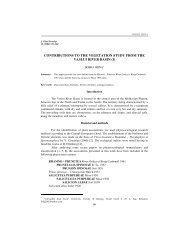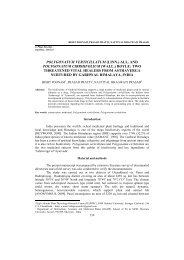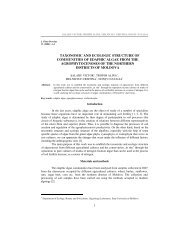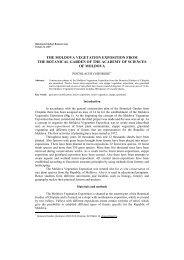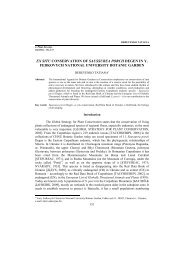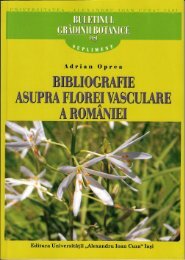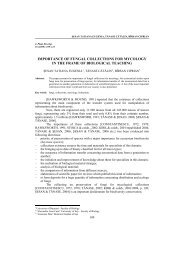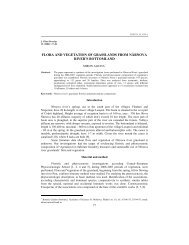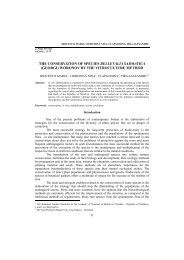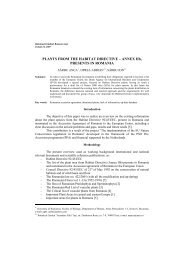buletinul grÄdinii botanice - Journal of Plant Development
buletinul grÄdinii botanice - Journal of Plant Development
buletinul grÄdinii botanice - Journal of Plant Development
Create successful ePaper yourself
Turn your PDF publications into a flip-book with our unique Google optimized e-Paper software.
38<br />
Utricularia vulgaris species in shallow waters can give us about water quality, this species<br />
being characteristic to the meso-eutrophic waters (table 1, rel. 7-10).<br />
3. Salvinio-Spirodeletum polyrhizae Slavnic 1956. This association is frequently<br />
met in the stagnant waters <strong>of</strong> Isac-Uzlina aquatic complex. The floating stratum is<br />
dominated by Salvinia natans and Spirodela polyrhiza; pretty abundant is Lemna minor<br />
too. In this association also appears Trapa natans and sporadically Nymphaea alba at the<br />
water surface. Submerged vegetation is represented by Ceratophyllum demersum,<br />
Myriophyllum spicatum and Potamogeton pectinatus. It is thought that the decaying<br />
organic matters sedimentation process is accelerated by this association, producing thus<br />
the colmatation pool phenomenon. The cover degree varies from 80% to 95% (table 1, rel.<br />
11-14).<br />
4. Lemno-Utricularietum vulgaris Soó 1928. The association appears in shallow<br />
waters <strong>of</strong> the complex, strongly colmatated and rich in decaying organic matters. Both<br />
strata, floating and submerged stratum are well individualized. On the water surface there<br />
are the dominant species, Lemna minor and Utricularia vulgaris. Salvinia natans and<br />
Wolffia arhiza are well representated too. In the submerged stratum Ceratophyllum<br />
demersum, Potamogeton trichoides and Potamogeton pectinatus vegetates. The vegetation<br />
cover degree varies from 70% to 80%. The association is characteristic to eutrophic waters<br />
(table 2, rel. 1-4).<br />
5. Hydrocharietum morsus-ranae Langendonk 1935. Unlike the previous<br />
presented associations which are unstable to the wind action because the most species are<br />
not fixed to the bottom, Hydrocharietum morsus-ranae association is a lot more stable.<br />
However, it prefers the sheltered places <strong>of</strong> the reed thickets clearings, through the big,<br />
peripheral individuals. Beside Hydrocharis morsus-ranae, in the floating stratum vegetates<br />
Lemna minor, Spirodela polyrhiza, Salvinia natans, etc. Submerged vegetation is<br />
represented by Myriophyllum spicatum, Ceratophyllum demersum and various<br />
Potamogeton species. The vegetation cover degree has values between 70-80%. The<br />
illustrating species for this association is characteristic to phosphates rich waters (table 2,<br />
rel. 5-7).<br />
6. Ceratophyllo-Hydrocharietum I. Pop 1962. It is a floating-submerged<br />
association, populating the shallow waters <strong>of</strong> the complex, with the maximum vegetating<br />
and fructifying period in July-August months. The characteristic species are Hydrocharis<br />
morsus-ranae and Ceratophyllum demersum. There is two strata: in the emerged stratum<br />
the first species is dominating, forming a cover containing also Lemna minor, Salvinia<br />
natans and Spirodela polyrhiza. The submerged stratum is abundant populated by<br />
Ceratophyllum demersum and sporadically Myriophyllum spicatum and Potamogeton<br />
pectinatus. Both strata are here and there penetrated by emerged hydrophytes like<br />
Schoenoplectus lacustris, Butomus umbellatus, Typha angustifolia or Phragmites australis.<br />
The cover degree average oscillates around 75% value. This association is developed on<br />
silt, organic substratum and eutrophic waters (table 2, rel. 8-9).<br />
7. Salvinio-Hydrocharietum (Oberd. 1957) Boşcaiu 1966. This association<br />
represents an transition stage between the floating groups <strong>of</strong> Lemnetea class and the fixed<br />
groups <strong>of</strong> Potametea class and prefers the100-125 cm depth waters. Characteristic species<br />
like Salvinia natans and Hydrocharis morsus-ranae vegetates side by side with Lemna<br />
minor, Spirodela polyrhiza, Utricularia vulgaris and Stratiotes aloides. The vegetation<br />
cover degree is high, about 85-90%. The association was described as populating the strong<br />
eutrophic waters (table 2, rel. 10-12).



